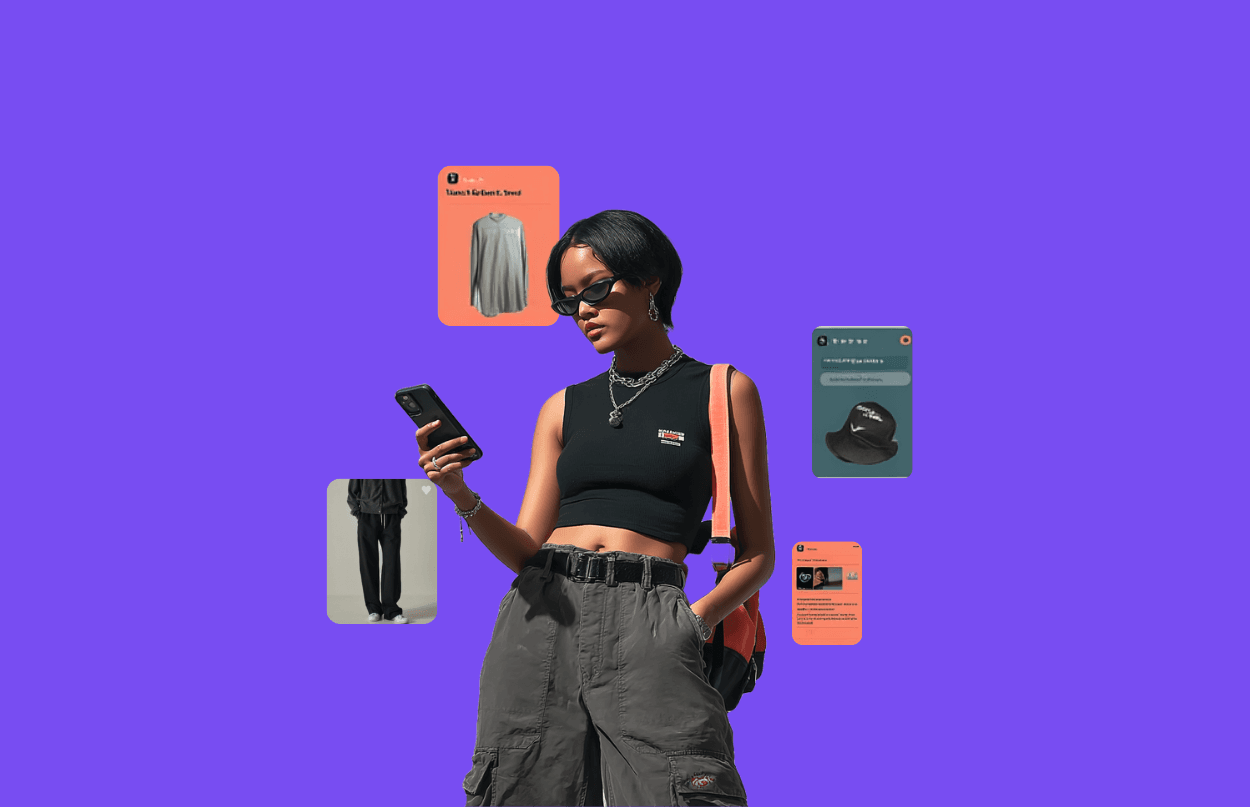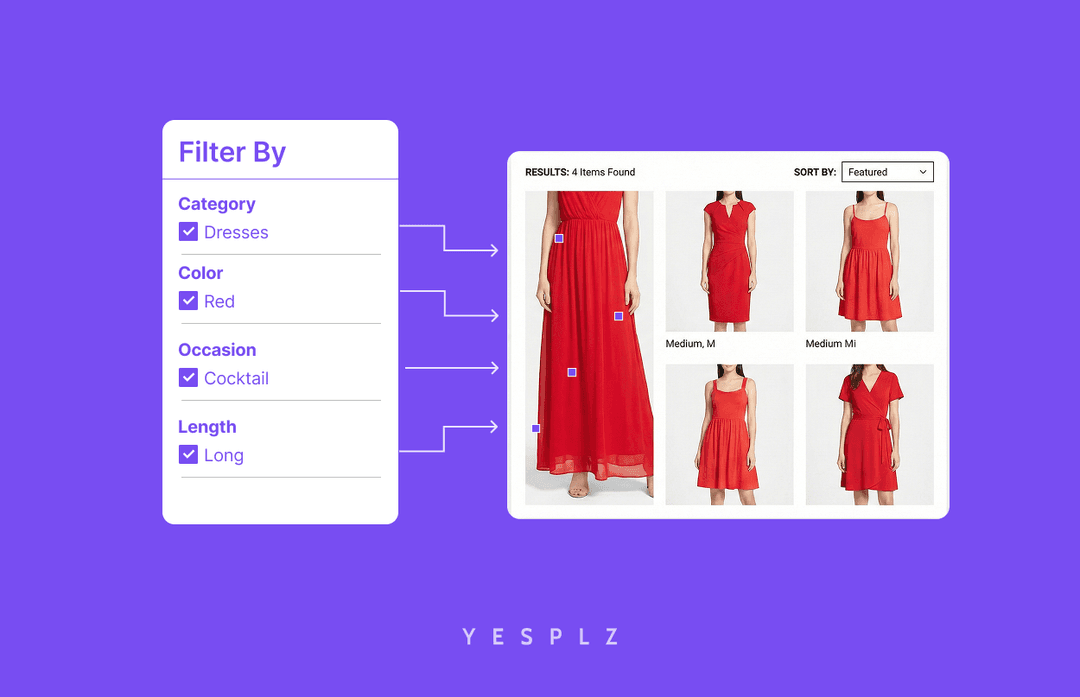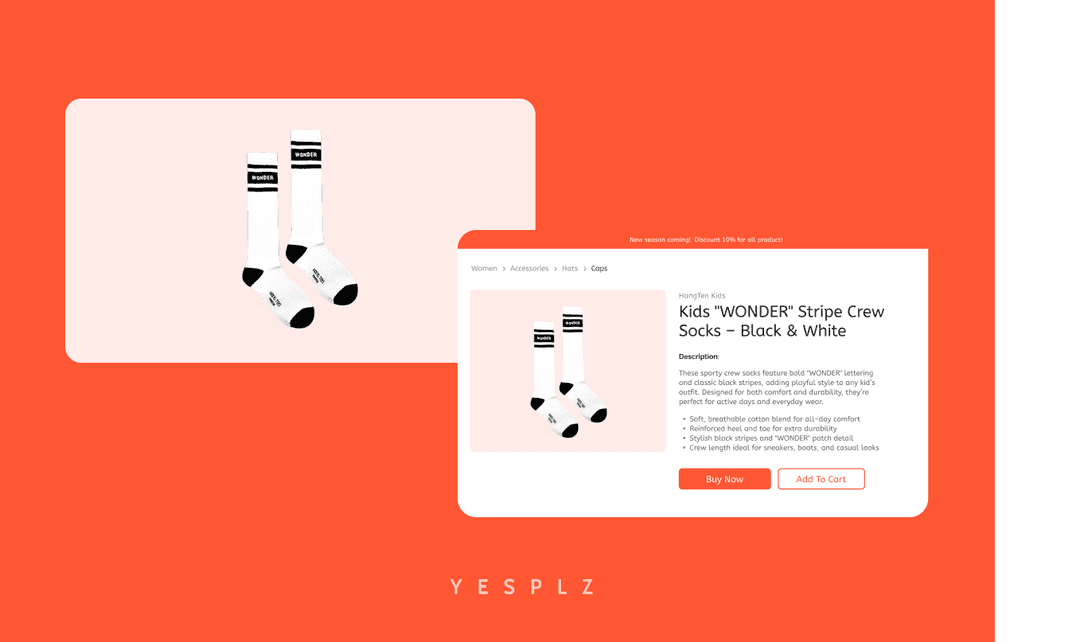Are you frustrated with how your fashion store search engine works? Learn how YesPlz fashion AI is reshaping the e-commerce landscape through AI-powered tagging and search!
by YesPlz.AIJuly 2025

Edith Head, an American costume designer, once said, “You can have anything you want in life if you dress for it.”
But how can a consumer dress the way she wants if she cannot find the clothes she needs?
The culprit? An antiquated fashion search engine. Fashion search engines usually cause frustration because they are outdated, clunky, and flawed.
The solution is to combine a search engine with AI image recognition, and you can make this happen with YesPlz. This article will help you understand not just the pain points of your consumer, how to solve them, but also how to take your fashion store to the next level.
Key Takeaways:
Improve customer retention with a simple tweak in your search engine
Save time and moneythousands of dollars by automating your tagging process
Traditional search engines will soon be obsolete
Image search is the new way to augment your search engine
If you are ready, let us start!
Have a close look at the screenshot below. The search term for this example is “brogues,” which is spelled correctly, and it is why this store shows shoes that belong to this category.

Now, what if the shopper misspells “brogues” like the one below?

The online store above shows irrelevant products—these are neckties, not brogue shoes.
Why is this happening, and is there a solution to it?
Traditional search engines rely on keywords and product tags, which means if there is a mismatch between these tags, naming conventions, spelling, and the user’s keyword, some products will never come up in the search results.
This mismatch results in missed sales opportunities. How can a customer buy something she cannot see? In many cases, the search result will show nothing, and if there is nothing to see, there is also nothing to buy, so the shopper will leave.
You just lost a customer right there, even if you have products that she is looking for.
An AI-powered search engine not only fixes this problem, but also does the following:
Image recognition
Domain specialization
Keyword updates (spelling, typo, synonyms, grammar, type of product, new words based on trends, etc.)
Automatic product tagging
Dynamic and faceted filtering
With an AI search engine for fashion, you can do away with manual tagging of products. You can also forget about keywords in the product title and description.
Here are the benefits:
More products on the search result page (relevant products only)
Higher sales
Reduced costs for human labor
But why do you need AI-powered searchsearc like this? Is fashion AI search just a hype, or is there something inherently broken with conventional search engines?
There are three main issues with traditional search. These are:
No contextual image awareness
No auto-updates for grammar, spelling, etc.
No specialization for any specific domain
Traditional fashion search engines do not “look” at images. What these basic programs do is match the search query to the product title, description, and nothing more.
If the shopper’s search keyword matches the product title or description, only then will the search engine show products in the results page.
For any mismatch, the search engine will not display the product, even if it fits the customer’s intent.
This is a problem because a shopper and a store manager may use different words even if they are referring to the same thing.
Going back to the example earlier, the shopper typed “brogs” instead of “brogues.” As you have observed, the store showed neckties even though the catalog has many pairs of brogues in it.
The search result is essentially telling the shopper, “We do not have brogs.” This shopper will certainly leave and look somewhere else.
If that store had an AI search engine, then the customer would have seen brogues even if he typed “brogs.”
Most AI search engines are not trained in a specific domain. They are generic in their function, which means they do not adapt and evolve.
Why is this a problem?
Fashion is highly dynamic. Now and again, there will be new trends, new words, new types of fabric, etc. To stay abreast, you need to label or tag each product accordingly.
Manual tagging for search is labor-intensive. Instead of driving down your costs, you are inflating them. But not with YesPlz AI. The system is trained specifically for fashion, and it will stay updated as fashion trends change.

Search engines without the power of AI do simple matching between a shopper’s keywords and the product's keywords. They are not equipped to understand the search intent of the buyer.
YesPlz works differently. If a shopper types “long-sleeved blue shirt,” the AI will know that this customer is looking for a shirt that is blue and that it must have long sleeves.
Because of this, the AI will show all products in your catalog that meet the following conditions:
Category: Shirts
Color: Blue
Features: Long Sleeves
Even if the product title or description does not carry these words (blue, long sleeves, shirt), the AI will “look” at the image from the catalog and display all products that meet these conditions.
 Noisy data refers to words in the product title or description that are irrelevant to the shopper’s search intent.
Noisy data refers to words in the product title or description that are irrelevant to the shopper’s search intent.
Let us say that a customer types “white-shirt” in the search box.
A traditional search engine may show a pair of pants in the search results. Why? Because the term “white t-shirt” is in the description (see image above).
The shopper, of course, will ignore this product because she is looking for a white shirt, not a pair of denim pants.
YesPlz Fashion AI eliminates this problem. It knows, from the image of the pants, that it is a pair of denim jeans. As such, the AI will not show this product to anyone searching for “white t-shirt.”
The benefit? Customers will never feel frustrated for seeing results that have nothing to do with what they are looking for.
The YesPlz fashion AI recognizes spellings, synonyms, and new, trendy keywords. For example, the AI will show blue shirts even if the user typed “navy” in the AI fashion search box.
If the shopper typed “crop top” but the spelling of the product title in the catalog is “croptop,” the AI will still show this product to the user.
What is the benefit of this?
You do not have to lose sales just because the search keyword does not match your product title or description.
The AI will understand what the shopper is looking for and present relevant products even if the keywords are misspelled or merely a synonym.
The same thing goes for singular and plural forms of keywords. Usually, if a customer typed “skirts,” the search engine would not show products that do not contain the exact word “skirts.”
What this means is that products labeled as “skirt,” without the extra “s,” will not show on the search results, resulting in a loss of sales.
Many e-commerce store managers think that keyword variation can be achieved with more product tags. This line of thinking is not progressive. The correct solution is image search, which will be discussed next.
 Clothing comes in many names, but many of these are essentially the same. Traditional search engines do not know this, but YesPlz AI does.
Clothing comes in many names, but many of these are essentially the same. Traditional search engines do not know this, but YesPlz AI does.
For instance, a hump skirt and a mini skirt are both short skirts. A Henley shirt is the same as a camisa de chino.
Now, if your customer uses “hump skirts” in the search box, a conventional search engine will not show products labeled as “mini-skirt.”
This results in a loss in sales.
The solution? An integrated image-based AI fashion search system.
YesPlz AI detects product characteristics from the images. This is beneficial, especially if there are regional differences in the words or names that shoppers use.
For example, someone in the West may search for a Henley shirt in your store, which you have in the catalog, but someone in Asia may use the search term camisa de chino.
Without a fashion AI, your search engine will not show the Henley shirt to the Asian shopper, even if it exists in the catalog.
The shopper would think you have no camisa de chino, and you would have lost that sale.
This will not happen with YesPlz. The machine knows that a Henley and a camisa de chino are similar, so it will show the same product no matter which of these two search terms was used.

Tagging is an essential part of e-commerce. The problem with it is two-fold:
Too labor-intensive – someone has to tag each product.
Inconsistency – a person may not tag a product correctly, or they may miss tagging it according to a specific characteristic.
YesPlz AI will help you reduce the cost of manual work as it tags products automatically. It not only tags basic things like color, category, or size, but also characteristics such as:
Occasion
Print type (plain, checkered, animal, etc.)
Sleeve length
Material
Neckline
And so much more
What is this for? Tags are fed to the search engine, which means that a product will appear in search results if it is appropriately tagged. In addition, the tags play an important role in the effectiveness of “faceted filtering,” which will be explained later.
Faceted Filtering, also referred to as Faceted Search or Navigation, allows users to narrow the results of their search. Users can toggle a range of attributes (size, brand name, length, etc.), or “facets.”
The whole purpose of the filter is to make it easier for the shopper to find what they are looking for. This feature, especially in the fashion industry, is critical. Because of this, e-commerce managers want to ensure the filtering is optimized for fashion shoppers.must spend a lot of time building this structure.
With YesPlz fashion AI, you no longer have to worry about it. We automatically handle it. Here’s a screenshot of how it works:

The results page above has multiple filters, or facets. Specifically, the user can toggle products by neckline type and sleeve type.
Ordinary filtering means the shopper can only use one filter at a time, like the neckline type, but not both neckline and sleeves.
Faceted filtering, on the other hand, makes it possible for the shopper to tell the store, “I only want to see products that meet my neckline condition and sleeve condition.”
Once a customer selects her preferences on these two filters (neckline and sleeves), the AI will search the database for products that meet these two conditions and show the appropriate results.
And how does this work? It all works thanks to AI tagging—you do not need to tag all the details (of facets) of each product. The AI does it all automatically!
YesPlz automatically tags products —you no longer need to assign each product to each category, and the search filters will also change on their own.

All the features and benefits we discussed can be yours. YesPlz gen AI for fashion integrates with any fashion store—all we need is the product image, and we will do the rest.
It takes about two to four weeks to complete the integration. This is what happens in a typical set-up:
Week 1 – data integration | submit your images to us
Week 2 – AI learning | the YesPlz AI will analyze your content
Week 3 – API configuration | this refers to the integration of YesPlz with your store
Week 4 – review | sort out issues
The fifth week is when we launch. By this time, we should have resolved all issues. From here, the AI will keep learning. It will also be monitored continuously.
We recommend that you schedule a call with us to see a live demo. At this time, one can no longer deny the role of AI in business, especially in fashion.
It is highly recommended that you switch from conventional search engines to YesPlz, the best AI fashion search engine.
Do this to keep up with the changing times, cut on operational costs, and improve your conversion.

Written by YesPlz.AI
We build the next gen visual search & recommendation for online fashion retailers

Stop losing sales to poor product filtering. Discover how AI simplifies creating Shopify filters, saving you 25-50 hours per 100 products.
by YesPlz.AI

Automate Shopify product pages and cut 50–100 hours of manual work. AI generates product titles, descriptions, and metadata instantly from product images.
by YesPlz.AI